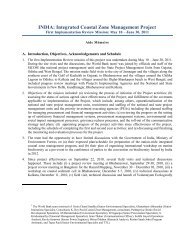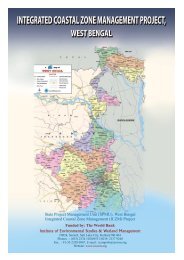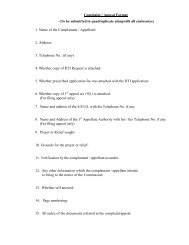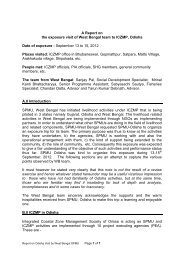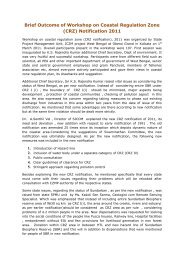Cyclone and Storm Surge - Iczmpwb.org
Cyclone and Storm Surge - Iczmpwb.org
Cyclone and Storm Surge - Iczmpwb.org
Create successful ePaper yourself
Turn your PDF publications into a flip-book with our unique Google optimized e-Paper software.
4.2<br />
In US, there is a steady decrease in the death toll caused by tropical cyclones with an average death<br />
toll of 7,000 during 1900-1910, 1,000 during 1950-1960 to only around 200 during 1990-1995<br />
(Southern, 1991). This is attributed to effective warning system, good response from the affected<br />
community <strong>and</strong> proper mitigation plan. In contrast, the property damage has been increased<br />
considerably due to increasing activity in the coastal region <strong>and</strong> increase in material <strong>and</strong> labor cost.<br />
However, in Southeast Asia <strong>and</strong> particularly in Indian region, there is no significant decrease in loss<br />
of life, which is being reflected by the death toll of about 1,31,000 in 1991 Bangladesh cyclone <strong>and</strong><br />
about 10,000 in 1999 Orissa super cyclone. At the same time, the damage to properties has been<br />
increased sharply in last few decades.<br />
In the present study, the past datasets about the occurrence to tropical cyclones over this region (the<br />
Bay of Bengal cyclones in the Indian region) is analyzed to determine the locations of high hazard<br />
incidence.<br />
4.2. Data Analysis<br />
As mentioned above, the vulnerability of the West Bengal coastal districts / blocks are assessed by<br />
analyzing the past cyclone datasets. For this purpose, the 114 years (1891-2004) past cyclone<br />
datasets obtained from India Meteorological Department (tropical cyclone Atlas <strong>and</strong> other scientific<br />
documents & journals) <strong>and</strong> Joint Typhoon Warning Centre (JTWC, USA), are used. The datasets<br />
used to find out the number / percentage of storms / severe storms (developed over the Bay of<br />
Bengal) crossed various countries bordering the Bay of Bengal <strong>and</strong> storms dissipated over the<br />
ocean. Further, the frequency of storms/ severe storms crossing various state boundary of India is<br />
calculated.<br />
Figure-1 shows the number <strong>and</strong> percentage of cyclones crossing Indian coast-line <strong>and</strong> coast-line of<br />
other countries viz., Bangladesh, Myanmar, Sri Lanka <strong>and</strong> those dissipated over the ocean itself.<br />
This clearly shows that most of the cyclones developed over the Bay of Bengal crosses Indian coast<br />
line (60.8%), the next highest being the number of cyclones dissipated over the sea. Thus in terms of<br />
frequency, among the countries bordering Bay of Bengal, India is most vulnerable. It is must be<br />
mentioned here that the vulnerability due tropical cyclones cannot be determined by solely by its<br />
frequency of occurrence, the vulnerability depends on associated storm surge, coastal inundation /<br />
flooding <strong>and</strong> socio-economy of the possible affected region.









